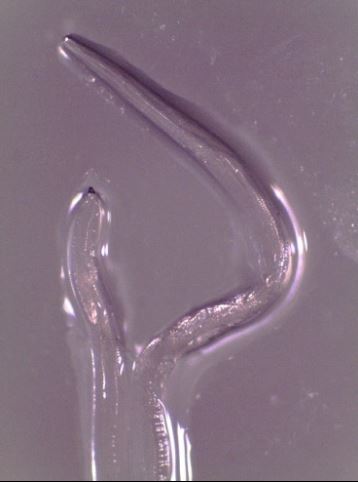Weird Worm Crawling in Oregon Woman's Eye Has Only Been Seen in Cows

It's certainly horrifying to discover small translucent worms squirming through your eyeballs. But what if those worms have never been found in human eyes before?
That's what happened to a 26-year-old woman in Oregon who thought she felt something in her eye — and that something turned out be a parasitic eye worm that previously had been known to infect only cattle, according to a new report from researchers at the Centers for Disease Control and Prevention (CDC).
The case, published today (Feb. 12) in the American Journal of Tropical Medicine and Hygiene, marks the first time that this species of eye worm, called Thelazia gulosa, has been seen in humans, the researchers said. ['Eye' Can't Look: 9 Eyeball Injuries That Will Make You Squirm]
"Cases of eye worm parasitic infections are rare in the USA, and this case turned out to be a species of the Thelazia that had never been reported in humans," Richard Bradbury, lead author of the report and a researcher at the CDC's Division of Parasitic Diseases and Malaria, said in a statement. "Previously, it was thought that there were only two different species of these [Thelazia] eye worms that infected humans worldwide. Now, we have to add Thelazia gulosa, a third one, to the list," Bradbury said.
Thelazia eye worms are found in a number of animals, including cats, dogs, foxes and cattle; but they don't usually infect people. The worms are transmitted by different types of flies that feed on tears, the researchers said.
In the new case, which occurred in August 2016, the woman first reported feeling like there was something in her eye. A week later, she pulled a small worm out of her eyeball.

The women went to see several doctors, including an optometrist and an infectious disease specialist; and over the next 20 days, 14 more worms were removed from her eye. The worms were less than half an inch long (1.3 centimeters), and were found in the conjunctiva, or the clear membrane that covers the white part of the eye.
Sign up for the Live Science daily newsletter now
Get the world’s most fascinating discoveries delivered straight to your inbox.
In some cases, doctors use an anti-parasitic drug called Ivermectin to treat eye worms. In the woman's case, however, she didn't need the drug because her infection went away after the worms were removed, and she didn't have any more symptoms, the researchers said.
Eye worm infections are more typically seen in older adults and young children, who may be less able to keep flies away from their faces, the researchers said.
The researchers suspect the woman got the infection when she was exposed to face flies (Musca autumnalis) while horseback riding and fishing along the coast of Oregon, in a region where cattle farming is common.
Bradbury said this case doesn't mean that T. gulosa is now more likely to infect humans than before. "This is almost certainly just an unfortunate, random, event," Bradbury told Live Science in an email. It's possible that T. gulosa has infected people before, but it was misidentified as another species of eye worm, he said.
People usually recover from eye worm infections after the worms are removed, but in some cases, the infection can cause scarring of the cornea and even blindness if the worms migrate across the surface of the eye, the researchers said.
Several worms that were removed from the Oregon patient were sent to a CDC laboratory, where they were identified as cattle eye worms. The researchers initially thought the infection was caused by a type of worm called Thelazia californiensis, because this was the only species of eye worm known to infect humans in the U.S.
"It was only after we looked more carefully that we realized some differences in anatomy that meant it could not be T. californiensis," Bradbury said. "We had to go back to papers published in German back in 1928 to help identify this worm as Thelazia gulosa," he said.
Original article on Live Science.

Rachael is a Live Science contributor, and was a former channel editor and senior writer for Live Science between 2010 and 2022. She has a master's degree in journalism from New York University's Science, Health and Environmental Reporting Program. She also holds a B.S. in molecular biology and an M.S. in biology from the University of California, San Diego. Her work has appeared in Scienceline, The Washington Post and Scientific American.









